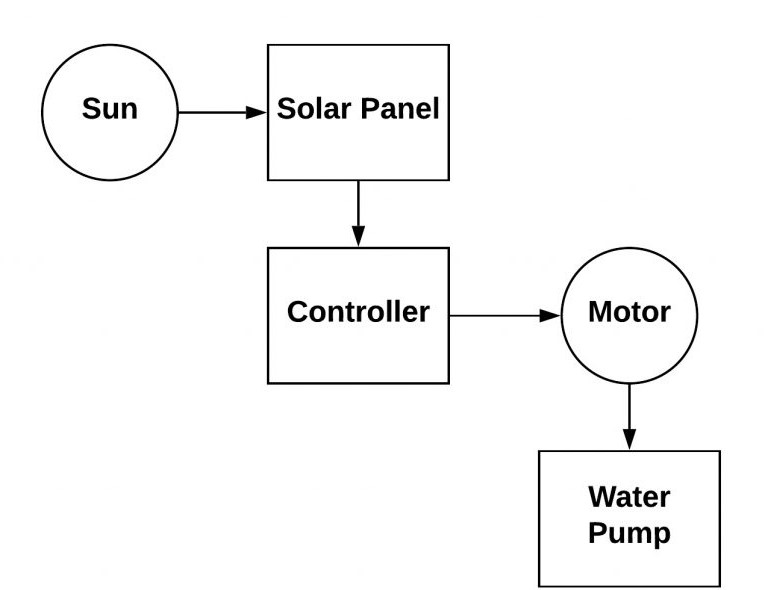Solar Pumping System
What is Solar Pump?
Solar pump definition is, as the name suggests the pump uses solar energy to function. Solar-pumps are robust, installation is simple, minimum maintenance is necessary and very expensive when we compare with normal water pumps. The life span of these pumps is a maximum of 20 years. But time to time the solar panels need to be cleaned for running. These kinds of pumps mainly used where there is an electricity problem otherwise consistent power supply is not accessible.
Solar Pump Block Diagram
The solar pump block diagram mainly includes a solar panel, water pump, electric motor, and controller. This pump is basically an electrical pump, and this pump uses the electricity which is received from the solar panels to work. These panels store the energy from the solar. The electric motor manages the alternating current or direct current. The controller used in this system adjusts the output power as well as speed.
How Does Solar Pump Work?
When the solar energy drops sun rays on the PV panels then the solar panel converts the rays into electrical energy with the help of Si wafers fixed within the PV panels. Then the solar energy supplies to the electrical motor to operate the pumping system using cables. By the revolution of the shaft which is fixed to the pump, then the pump begins to pick up the soil water and supplies to the fields.
Solar Pump Types
The solar-pumps are classified into four types namely submersible solar pumps, surface solar-pumps, DC pumps, and AC pumps.
Submersible Solar Pumps
These pumps can lift the water up to 650 feet and fit within a big well. Whenever the water deepness in the well is above 20 feet from the surface then these pumps can work straightly turn off batteries, solar panels, otherwise power source in some cases. Generally, water is pumped throughout the day as the sun is shining & the water is stored in a tank for utilize whenever required. It is suggested to store the water only in a good weather condition because if the weather is not good then the water will not pump. These types of pumps mainly used in places wherever water is accessible at a larger depth & wherever open wells do not exist. The highest suggested depth for pumping is 50 meters.Surface Solar Pumps
These pumps are used in ponds, shallow wells, storage tanks otherwise streams. If the deepness of the water supply in the well is 20 feet or less than 20 feet from the surface. Generally, these pumps can’t pick up the water very high from the deep well, they can push the water 200 feet or above distance. These pumps are apt for pumping as well as lifting water from the highest deepness of 20-meters.DC Solar Pumps
The motor used in this kind of pump works with direct current, thus there is no need for inverter or battery.AC Solar Pumps
The motor used in this kind of pump works with AC, which means the DC generated by the panels gets changed to AC with the help ofan inverter. This conversion leads to power failure from production & utilization.
How to Select Solar Panels?
The solar panels which are used to power the water pumps are sold singly. Every solar panel maker provides a table that gives the information about how many amps, watts and volts of power they require to generate the preferred water flow otherwise pick up. Whenever you have chosen the suitable type of solar-pump, then utilize that graph to estimate the accurate watts of panels.
The required amount of panels, as well as pumps, mainly depends on how many GPD (gallons per day) otherwise GPM (gallons per minute) you wish to pump.
Solar Pump Advantages
- The installations of solar pumps are flexible & applicable to different applications.
- It allows people to handle their water supply for drinking, farm animals watering, irrigation, & other housing applications.
- Generally, the usage of water in summer is utmost. During this season, the PV panels can generate the most power so that more water can be pumped into the water tank.
- Because of the ease of PV power-driven water pumps, solar technology is consistent, as well as needs small protection.
Solar Pump Disadvantages
- It is expensive.
- The output of the panel will depend on the weather.
- It requires a water storage tank as well as a battery.
Solar Pump Applications
- Water supply for animals
- Water supply for harvest irrigation
- Water supply for Cooking and Drinking water supply.



